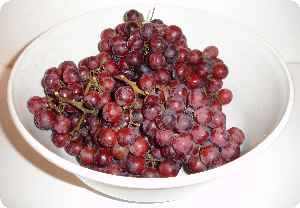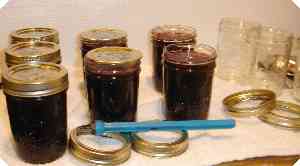
Grape Picking Tips and Facts
Grape Picking Tips and Facts
 If
you are about to pick grapes either directly from a tree, or from a local
orchard or market, here's what you need to know to pick the best grapes.
If
you are about to pick grapes either directly from a tree, or from a local
orchard or market, here's what you need to know to pick the best grapes.
Grapes are a fairly early crop, flowering soon after the last frosts in April and May, setting fruit in June, usually at the same time as strawberries in most areas (but check your area's harvest calendar and call the farm or orchard you are planning to go to a few weeks ahead).
Types of Grapes
There are several; types of grapes:
- Table Grapes for eating fresh and making juice and jelly, can be seedless or with seeds. See this page for a master list and guide to table grape varieties
- Wine Grapes... for making wine. See this page for a master list and guide to wine grape varieties
- Muscadines and Scuppernongs, Large, very sweet southern grapes with large seeds
Grape picking tips
- Pick ripe: Grapes do not ripen after they are picked
- Appearance: Look for heavy, firm grapes
- To harvest grapes, carefully cut the grape clusters from the vine using pruning shears. Be careful not to bruise or damage the fruit or the surrounding vines.
Grape recipes, canning, jelly making juice, etc
- Grape jelly from fresh grapes
- Grape jelly from grape juice (canned, bottled or frozen)
- How to make your own grape juice, scuppernong, juice, muscadine juice. - W, P
Grape varieties
Grapes are grown throughout the United States and Canada, and there are numerous varieties grown across different regions of the countries. These grape varieties differ in their characteristics, flavor profiles, and ideal growing conditions.
Table Grape Varieties
Here are some of the more commonly grown grape varieties:
- Thompson Seedless: Green grapes, often used for eating fresh or making raisins.
- Red Globe: Large, round red grapes with a sweet flavor,
commonly used as table grapes.
- Flame Seedless: Red grapes known for their sweet taste and crisp texture.
- Crimson Seedless: Seedless red
grapes, similar in flavor and appearance to Flame Seedless.
- Autumn Royal: Large, black grapes with a sweet flavor, usually harvested in late
summer or early fall.
Muscadines and Scuppernongs:
- Muscadines: Native to the Southeastern United States, these grapes have thick skins and a sweet, musky flavor. They come in various colors,
including black, bronze, and purple.
- Scuppernongs: A specific type of muscadine grape, known for its large size, bronze color, and sweet
flavor.
Seedless Grape varieties:
- Sugarone: Seedless green grapes with a crunchy texture and a sweet-tart flavor.
- Autumn King: Seedless, large green grapes known for their
crispness and sweetness.
- Sweet Jubilee: Seedless red grapes with a balanced sweetness and a hint of tartness.
- Princess Seedless:
Blue-black grapes with a sweet flavor and firm texture.
- Scarlet Royal: Seedless red grapes with a juicy and sweet taste.
Common table grape varieties
1. Concord Grapes:
- Concord grapes are one of the most well-known grape varieties in the U.S., often used for making grape juice, jellies,
and jams.
- They are predominantly grown in the Northeastern United States, particularly in New York, Pennsylvania, and Ohio.
- Concord grapes
are ready for harvest in late summer or early fall when the berries turn deep purple with a slight bloom. The fruit should be firm but not overly
soft.
- To harvest Concord grapes, gently twist or cut the clusters from the vine. Handle them carefully to avoid damaging the delicate skins.
2. Thompson Seedless Grapes:
- Thompson Seedless grapes, also known as Sultana, are a popular green grape variety in the U.S., favored for
eating fresh, making raisins, or using in salads.
- They are primarily grown in California, where the Mediterranean climate provides ideal
conditions for grape cultivation.
- Thompson Seedless grapes reach their peak ripeness in late summer. Look for a pale green color, slightly
translucent berries, and a sweet fragrance.
- To harvest Thompson Seedless grapes, carefully cut the grape clusters from the vine using pruning
shears. Be cautious not to damage the fruit or the surrounding vines.
3. Cabernet Sauvignon Grapes:
- Cabernet Sauvignon grapes are widely
recognized as a classic red wine grape variety, known for producing full-bodied and complex wines.
- They are predominantly grown in California,
particularly in the Napa Valley and Sonoma regions, but can also be found in other states such as Washington and Oregon.
- Harvesting Cabernet
Sauvignon grapes is typically done in early to mid-fall when the berries have reached their optimal sugar and tannin levels. The grapes should have
a deep, dark color and a rich flavor.
- When harvesting wine grapes, it is essential to consider the winemaker's desired characteristics. Grapes
can be hand-picked or machine-harvested, depending on the vineyard's practices.
It's important to note that grape harvesting times can vary depending on the specific region and local climate conditions. Additionally,
different grape varieties may have slightly different harvesting techniques. Always consult local resources, vineyard experts, or agricultural
extension services in your area for precise information on grape varieties, growing regions, and harvest timing.
Properly harvested grapes can be enjoyed fresh or used in various
culinary applications such as winemaking, cooking, or preserving.
How to pick the grapes from the tree
- When harvesting grapes, it is crucial to handle the fruit gently to avoid bruising or damaging the berries.
- Clippers are normally used
- Don't overfill your containers or try to pack the grapes down.
General Picking Tips
Whether you pick Grapes from your own trees, a market or at a Pick-Your-Own farm, here are a few tips to keep in mind:
- Part the leaves with your hands to look for hidden grapes ready for harvest.
- Avoid placing the picked grapes in the sunshine any longer than necessary. It is better to put them in the shade of a tree or shed than in the car trunk or on the car seat.
- Cool them as soon as possible after picking. Grapes may be kept fresh in the refrigerator for two or three days, depending upon the initial quality of the berry.
Before you leave to go to the farm:
- Always call before you go to the farm - Grapes are affected by weather (especially rain and cooler temperatures) more than most crops. And when they are in season, a large turnout can pick a field clean before noon, so CALL first! Always call before you go to the farm - Grapes are affected by weather (especially rain and cooler temperatures) more than most crops. And when they are in season, a large turnout can pick a field clean before noon, so CALL first!
-
 Leave
early. On weekends, then fields may be picked clean by NOON!
Leave
early. On weekends, then fields may be picked clean by NOON! -
Most growers furnish picking containers designed for Grapes, but they
may charge you for them; be sure to call before you go to see if you need to
bring
containers.
If you use your own containers, remember that heaping Grapes more than 3 inches deep will smush the lower grapes. Plastic dishpans, metal oven pans with 3 inch tall sides and large pots make good containers. I like the Glad storage containers like the one at right. - Bring something to drink and a few snacks; you'd be surprised how you can work up a thirst and appetite! And don't forget hats and sunscreen for the sun. Bugs usually aren't a problem, but some deet might be good to bring along if it has been rainy.
When you get home
- DON'T wash the grapes until you are ready to use them. Washing makes them more prone to spoiling.
- Grapes are more perishable than blueberries or strawberries, so make a point of refrigerating them as immediately as possible after purchase. Temperatures between 34 F and 38 F are best, but, be careful not to freeze grapes! (Fresh grapes are highly prone to freeze damage).
- Pour them out into shallow pans and remove any mushed, soft or rotting grapes
- Even under ideal conditions grapes will only keep for a few days in a refrigerator, so for best flavor and texture, consume or freeze them as soon as possible after purchase.
- See my How to freeze berries page. (Unless you're going to make jam right away)
- Now, get ready to make Grape jam - It is VERY easy - especially with our free Grape preserves instructions - illustrated and easy or grape pie filling
Grape Recipes, Canning, Jam, Jelly, and related resources
- Grape preserves instructions - illustrated and easy
- Grape jelly
- Grape pie filling
- Grape butter
- Grape festivals
- Grape pitters - reviews and where to get them
- How to pit grapes - several methods
Grape varieties
For a master table of grape varieties in the order in which they ripen, click here.
Grape Nutritional Information
Wikipedia and the USDA provide the following nutritional analysis of grapes
|
|||||||||||||||||||||||||||||||||||||||||||||||||||||||||||||||||||||||||||||||||||||||||||||||||||||||||||||||
As raw fruit, sweet grapes provide little nutrient content per
100 g serving (nutrient table). Dietary fiber and vitamin C are
present in moderate content while other vitamins and dietary
minerals each supply less than 10% of the Daily Value (DV) per
serving, respectively (table).
Compared to sweet grapes,
raw sour grapes contain slightly higher content per 100 g of
vitamin C (12% DV) and vitamin A (8% DV) (table).
Questions and Answers and other tips!
I want to make grape juice and grape jam. Do you know how I could extract the juice, getting rid of the pits?
There are various types of grape pitters that are easy and effective. Juicers tend to jam on the pits (if you know of a brand of juicer that is reliable and effective with grapes, write me!
See this page about grape pitters. Once pitted, juicers work great:
See here for related tools, equipment, supplies on Amazon See here for related tools, equipment, supplies on Amazon See here for related tools, equipment, supplies on Amazon See here for related tools, equipment, supplies on Amazon
Looking for canning equipment and supplies?
Water bath canner with a jar rack
Pressure canners for gas, electric and induction stoves: Presto 23Qt or T-fal 22Qt
Canning scoop (this one is PERFECT)
Ball Blue book (most recent version)
Jars: 8oz canning jars for jams
Find Other types of farms:
Farm markets and roadside stands
Road trips and camping resources
Local Honey, apiaries, beekeepers
Consumer fraud and scams information
Home canning supplies at the best prices on the internet!
Maple Syrup Farms, sugarworks, maple syrup festivals
Environmental information and resources
Farms For Your Event for birthday parties, weddings, receptions, business meetings, retreats, etc.
Festivals - local fruit and vegetable festivals
Get the
most recent version of
the Ball Blue Book
With this Presto 23 quart pressure canner and pressure cooker, you can "can" everything, fruits, vegetables, jams, jellies, salsa, applesauce, pickles, even meats, soups, stews. Model 01781

You can make jams, jellies, can fruit, applesauce, salsa and pickles with water bath canners, like this Granite Ware 12-Piece Canner Kit, Jar Rack, Blancher, Colander and 5 piece Canning Tool Set

